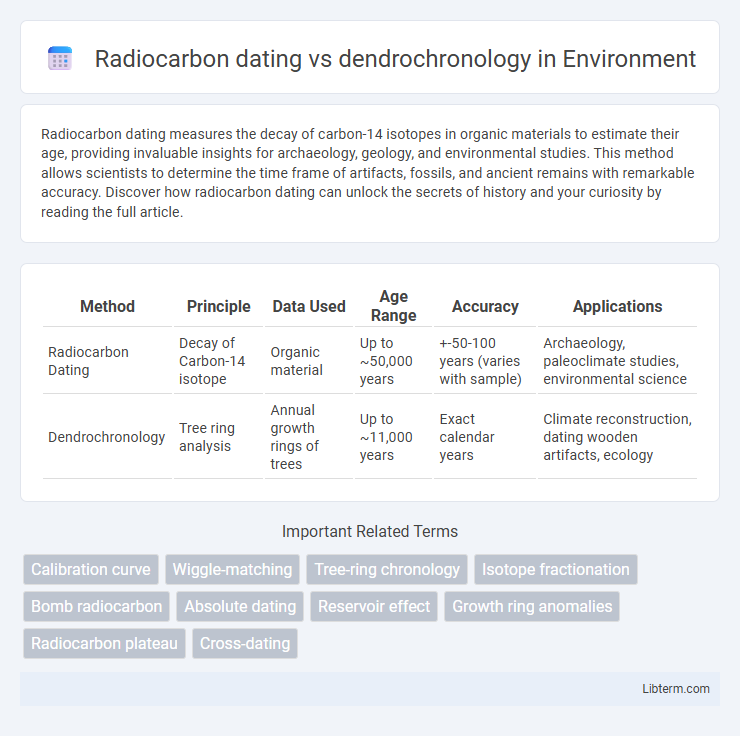Radiocarbon dating measures the decay of carbon-14 isotopes in organic materials to estimate their age, providing invaluable insights for archaeology, geology, and environmental studies. This method allows scientists to determine the time frame of artifacts, fossils, and ancient remains with remarkable accuracy. Discover how radiocarbon dating can unlock the secrets of history and your curiosity by reading the full article.
Table of Comparison
| Method | Principle | Data Used | Age Range | Accuracy | Applications |
|---|---|---|---|---|---|
| Radiocarbon Dating | Decay of Carbon-14 isotope | Organic material | Up to ~50,000 years | +-50-100 years (varies with sample) | Archaeology, paleoclimate studies, environmental science |
| Dendrochronology | Tree ring analysis | Annual growth rings of trees | Up to ~11,000 years | Exact calendar years | Climate reconstruction, dating wooden artifacts, ecology |
Introduction to Radiocarbon Dating and Dendrochronology
Radiocarbon dating measures the decay of carbon-14 isotopes in organic materials to estimate age, useful for samples up to about 50,000 years old, providing a quantitative timeline for archaeological and geological research. Dendrochronology analyzes tree ring growth patterns to determine chronological sequences and past environmental conditions, offering precise annual dating and calibration for radiocarbon results. Combining these methods enhances accuracy in dating historical artifacts and understanding climatic changes over millennia.
Principles of Radiocarbon Dating
Radiocarbon dating measures the decay of carbon-14 isotopes in organic materials to estimate age, relying on the principle that living organisms constantly absorb carbon-14 until death, after which the isotope decays at a known half-life of approximately 5,730 years. This method allows dating of artifacts up to around 50,000 years old, providing chronological context for archaeological and geological samples. In contrast, dendrochronology uses tree ring patterns to date wooden samples with annual precision but is limited to the lifespan and preservation of the trees themselves.
Fundamentals of Dendrochronology
Dendrochronology relies on analyzing tree ring patterns to establish precise annual dates by matching growth rings within a chronological sequence, providing a direct calendar age for wooden samples. This method depends on crossdating techniques that compare ring-width variations influenced by climatic conditions, offering insights into past environmental changes. Unlike radiocarbon dating, which measures isotopic decay to estimate age, dendrochronology offers exact year-by-year resolution for dating wooden artifacts and historical events.
Material Requirements and Limitations
Radiocarbon dating requires organic materials containing carbon isotopes, such as wood, charcoal, or bone, but results can be affected by contamination and calibration challenges. Dendrochronology relies on well-preserved tree rings from specific species and regions, limiting its applicability to wooden artifacts or environmental samples with clear growth ring patterns. Both methods face limitations: radiocarbon dating is restricted by the half-life of carbon-14 (~5,730 years), while dendrochronology depends on the availability of continuous and regionally matched reference chronologies.
Accuracy and Precision Comparison
Radiocarbon dating measures the decay of carbon-14 isotopes in organic materials, offering age estimates with an accuracy range typically within +-50 to +-100 years for samples up to 50,000 years old. Dendrochronology, or tree-ring dating, provides annual precision by analyzing growth rings, achieving exact calendar-year accuracy for wooden samples. While radiocarbon dating handles older and non-wood samples with broader error margins, dendrochronology remains superior for precise chronological frameworks when timber is available.
Age Range and Chronological Resolution
Radiocarbon dating effectively measures organic material up to approximately 50,000 years old, offering a broad age range but with a chronological resolution that can vary from decades to centuries depending on sample quality and calibration curves. Dendrochronology, or tree-ring dating, provides annual resolution but is limited to dating wooden samples within the lifespan of the tree species, often covering up to several thousand years. While dendrochronology offers precise calendar-year dating for recent periods, radiocarbon dating is essential for older samples beyond the range of tree-ring records.
Applications in Archaeology and Geology
Radiocarbon dating provides precise age estimates for organic archaeological artifacts up to 50,000 years old by measuring the decay of carbon-14 isotopes, critical for understanding prehistoric human activity and paleoenvironments. Dendrochronology complements this by offering exact calendar years through tree-ring analysis, ideal for dating wooden structures, climate events, and geological episodes within the last 10,000 years. Combining both methods enhances chronological frameworks and cross-validation in archaeological site dating and geological climate reconstructions, improving the accuracy of historical timelines.
Calibration and Cross-Validation Methods
Radiocarbon dating requires calibration curves derived from dendrochronology to adjust for fluctuations in atmospheric ^14C levels over time, enhancing accuracy. Dendrochronology provides precise annual tree ring sequences that serve as a calibration benchmark, enabling cross-validation by matching radiocarbon dates with exact calendar years. The integration of these methods improves chronological precision in archaeological and geological analyses by correlating ^14C data with established tree ring records.
Common Challenges and Sources of Error
Radiocarbon dating and dendrochronology both face challenges such as contamination and calibration errors that affect accuracy in age estimation. Radiocarbon dating struggles with fluctuations in atmospheric 14C levels and potential sample contamination, while dendrochronology can be limited by missing or false rings and regional growth variations. Both methods require careful cross-verification and calibration to minimize errors and improve chronological reliability in archaeological and environmental studies.
Choosing the Appropriate Dating Technique
Radiocarbon dating is ideal for estimating the age of organic materials up to 50,000 years old by measuring the decay of carbon-14 isotopes, making it suitable for archaeological and geological samples with no precise annual growth records. Dendrochronology offers exact calendar-year dating by analyzing tree ring patterns, excelling in dating wooden artifacts or environmental data where continuous, well-preserved tree ring sequences exist. Selecting the appropriate technique depends on the sample type, temporal range, and precision required for the research objectives.
Radiocarbon dating Infographic

 libterm.com
libterm.com